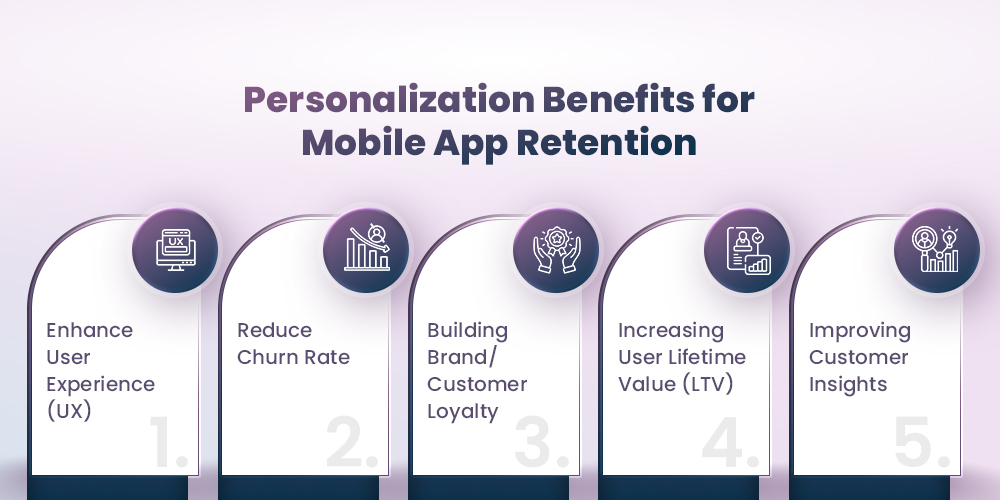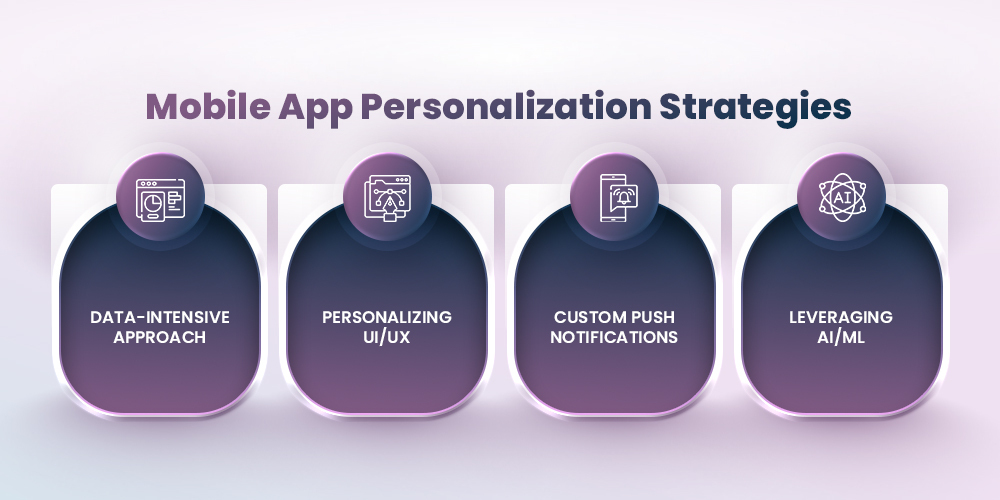Nowadays, it has become very crucial to implement app retention strategies to ensure users will re-engage with your iOS or Android mobile app. App retention is a significant metric to measure the success of any mobile app. By establishing a high mobile app retention rate, you can guarantee better user engagement and user loyalty.
Personalization in mobile apps means designing a tailored experience for each user according to his likes, dislikes, needs, behaviors, and preferences.This can be done by collecting user data and employing machine learning algorithms to provide the best customer experience.
The importance of personalization in mobile app retention strategies can be easily depicted by the fact that the average app retention rate drops from 23.65% on the first day to 4.13% on day 30 in iOS apps and from 23.01% to 2.59% in Android apps. Therefore, extreme personalization efforts must be carried out to retain more mobile app users.
Table of Content
Understanding Mobile App Retention
In simple terms, mobile app retention can be defined as the amount or percentage of times your mobile app users return to use the app after the first download within a specified period. So, it directly relates to user engagement. user experience, customer loyalty, brand loyalty, and user retention.
Many mobile app retention metrics are tracked to enhance your mobile app user retention by finding out ways to make customers keep returning your Android or iOS app. Some of these metrics are:
- DAU/MAU: It stands for daily active users or monthly active users and measures the consistently active users of your mobile app.
- LTV: It stands for the lifetime value of the user. LTV estimates the revenue a single user generates throughout their entire lifetime within an app.
- Session length: Session length refers to the average time an app user uses the app in one sitting or one session. The longer the session length, the better you can understand and plan for your customer, and the better the retention rate.
- Churn rate: This metric quantifies the number or percentage of users who have ceased using your app. It gives a clear indication of your app’s current performance.
Tracking and understanding these app retention metrics can help you better design your mobile app to meet your customer expectations and thereby resulting in better mobile app user retention.
Although retaining customers is not an easy task due high competition and high customer expectations. It requires an intense strategical approach to form your customer retention strategy.
Check out: How To Use Mobile App Retention Strategies To Win Loyal Customers in 2024?
What is Personalization in Mobile Apps
Personalization in mobile apps refers to the act of tailoring your mobile app according to each user’s personal preferences, behaviors, likes, dislikes, and past interactions. It is customer-centric and aims at providing a better customer experience, reducing churn rate, and increasing the number of users that re-engage with your Android or iOS mobile app.

In mobile apps, personalization can be done by inculcating features like personalized recommendations, custom push notifications, advanced data analytics, customized user interfaces etc.
MageNative–Mobile App Builder helps you build your fully personalized mobile app using drag and drop features.So what are you waiting for? Try Now!
Significance of Personalized Content for Mobile App Retention
Personalization is a powerful tool for mobile app user retention. By employing personalization strategies, you can better connect with your mobile app users. Since personalized mobile apps present content and features that directly align with your target customers, they uplift user engagement manifold.
App users always appreciate platforms that connect with them at a personal level and understand their preferences, thus personalization helps in improving customer satisfaction. With increased customer satisfaction, you can predict customers will return and re-engage. Thus, personalization helps not only the in-app user retention rate but also the conversion rate.
Benefits of Personalization for Mobile App Retention

Some of the benefits of mobile app personalization are listed below:
1. Enhance User Experience (UX)
You can improve your engagement strategy with intuitive UX elements like – personalized features, targeted notifications, relevant content, and more. These can help improve customer satisfaction thereby increasing your mobile app user retention rate.
2. Reduce Churn rate
Personalization can also help reduce the number of users who stopped using your app. One way to do this is by sending engaging personalized push notifications and offering discounts or offers.
3. Building Brand/Customer Loyalty
If users start perceiving your app as the one that understands their preferences and behavior, they are more likely to come back again and again. This builds trust and brand loyalty in the hearts of customers, resulting in a better app retention rate.
4. Increasing User Lifetime Value (LTV)
Since personalization enhances customer satisfaction and improves customer retention rates.Therefore, it leads to a higher monetary profit for a specific customer, thereby increasing his lifetime value.
5. Improving Customer Insights
Personalization involves collecting and analyzing users’s data. This helps in better understanding the customer and predicting future product development and marketing strategies, which will result in better user retention.
Unleash the power of mobile app builder. Build your own mobile app using MageNative. No Code Needed!
Try Now!
Personalization strategies for Mobile App Retention
There are several strategies that can be employed to implement personalization in your mobile app to provide an enhanced customer experience, build trust and loyalty, and improve the mobile app retention rate.

Some of these strategies are mentioned below:
1. Data-Intensive Approach
This approach involves depending on collecting and analyzing users’s data to provide a personalized experience. It deals with behavioral data like pages viewed, time spent, etc., and demographic data like users’ age, gender, location, etc. By leveraging user data, you can gather user insights, create and segment user profiles, and plan further activities for higher mobile app user retention.
2. Personalizing UI/UX
Personalized UI/UX can improve customer experience and satisfaction. This can be done by making customizable pages, including home screens, custom landing pages, etc., based on their preferences. Other such things include using customer-appropriate themes and colors and providing simple app navigation.
3. Custom Push Notifications
Push notifications act as a very great influence in maintaining app user retention by sending engaging and eye-catching targeted push notifications to mobile app users. When app users receive such notifications, they are driven towards opening it by seeing exciting and targeted offers. Thus, it results in an increase in mobile app retention rates.
4. Leveraging AI/ML
Various artificial intelligence (AI) and machine learning techniques are now being employed as mobile app retention strategies to increase the average app retention rate. Some of these techniques include predictive analytics, recommendation systems, and automated personalization.
Check out: Leverage AI Powered Custom Push Notification To Maximize Customer Retention
Challenges and Considerations
Although these personalization strategies have immense benefits, implementing them is not an easy task. There are several challenges and considerations that need to be taken care of before implementing any personalization strategy for improving your retention rates. These measures are important to ensure the success of the strategy.
Some of these challenges and considerations are mentioned below:
1. Data Privacy and Security
One of the major parts of personalization includes the collection and analysis of users’s private data. Maintaining the security of the confidential data shared by users has become a major responsibility. You have to ensure the privacy and security of the app’s users’s data and will be liable for any misconduct that may happen.
2. Ethical Considerations
Ethical considerations while employing personalization strategies for mobile app retention include removing any kind of bias that may arise due to faulty machine learning algorithms. This includes maintaining transparency and checking that the personalized suggestions do not become manipulative and remain within ethical boundaries.
3. Technical and Resource Constraints
Implementing personalization efforts can be a very resource-intensive process. Many issues regarding technical specifications and resource requirements can also arise. You need to make sure you are equipped with a skilled team that has enough knowledge about incorporating machine learning, AI, and data science algorithms to implement personalization strategies for mobile app retention.
FAQs
1. What is the good churn rate for mobile apps?
An annual churn rate of between 4% and 7% is seen as manageable. However, the exact number depends upon the kind of industry your mobile app belongs. For example, while some industries may tolerate higher churn rates, others may require stricter retention metrics. Therefore, it is important to analyze industry standards carefully. Generally, the churn rate of your mobile apps should be below 5%.
2. Why is mobile app personalization important?
Mobile app personalization is crucial as it not only enhances user engagement but also improves the customer experience and boosts customer satisfaction. Consequently, this ultimately leads to a higher retention rate. Furthermore, when users feel that an app is tailored to their needs, they are more likely to remain loyal.
3. How can I improve my retention rate?
You can improve the mobile app retention rate by personalizing your mobile app through features like targeted push notifications, data analytics, continuous optimization and user-relevant content. For instance, targeted push notifications can re-engage users. Additionally, data analytics helps understand user behavior. Moreover, continuous optimization ensures the app stays updated, and user-relevant content keeps users interested.
4. What is the success rate of mobile apps?
The success rate of mobile apps is relatively low. In fact, studies show that only around 0.01% of consumer mobile apps achieve commercial success. Moreover, implementing app retention effective strategies can help improve these odds.
5. What is the user retention metric for mobile apps?
User retention metrics for a mobile app include several key indicators, such as daily active users (DAU), monthly active users (MAU), churn rate, session length, and life-time value (LTV). These metrics are essential for understanding user engagement and app performance.
Conclusion
Personalization plays a very crucial role in employing mobile app retention strategies by providing tailored experiences. Personalization helps in building a better connection with your customers and provides an enhanced user experience and improved customer satisfaction.
Above, we discussed some of the benefits, strategies, and challenges of employing mobile app retention strategies to increase the average mobile app retention rate. As technology continues to evolve, some of the trends that can be expected in the near future in personalization include augmented reality (AR) and virtual reality (VR) in personalization, conversational AI in personalization, and hyper-personalization for higher retention.
As discussed above you should focus more on personalization efforts in order to drive greater mobile app user retention which will help to lead towards long-term success.
Unleash the power of personalization using MageNative Mobile App Builder. No Code Needed!
Try Now!
About The Author
I’m Anusha Ansari, a content writer and a tech enthusiast specializing in Shopify. I guide merchants to optimize their stores and grow their businesses. With skills in SEO and content writing, I ensure my articles are engaging and effective. I love exploring new apps and tech trends, sharing my insights to help others succeed.
Related Posts
Negative Customer Reviews: Causes, Impact & How to Handle Them the Smart Way
Did you know – “94% of consumers say a bad…
How to Reduce Product Returns and Increase Customer Satisfaction in Ecommerce
We live in a digital age where one tap on…
Reverse Image Search: The Next Big Feature Consumers Expect in Mobile Shopping Apps
Shoppers often know exactly what they want, but they struggle…